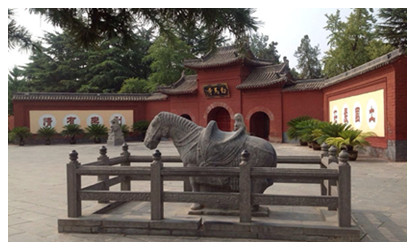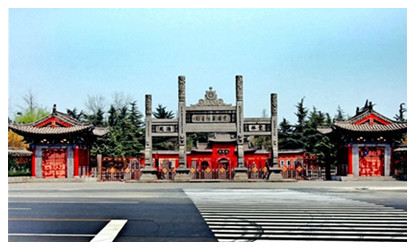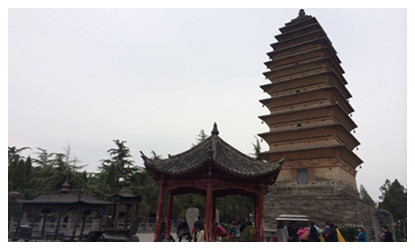Skype: neodalle-travel
Tel: +86 135 7447 2266
E-mail: sales@visitaroundchina.com
The White Horse Temple is located about seven miles away from Downtown Luoyang , in Central China's Henan Province.Covered with green ancient trees and appears solemn and tranquil, the White Horse Temple is one of the Luoyang Top Attractions which boasts  great antique architecture which has remained intact for over 1,900 years
great antique architecture which has remained intact for over 1,900 years
In the year 64 of the Eastern Han Dynasty (25-220), Emperor Ming sent a delegation of his men to study Buddhism in the western world. After three years, two eminent Indian monks, She Moteng and Zhu Falan, came back with the delegation. They brought with them a white horse carrying Buddhist sutras and Buddhist figures on its back. This was the first time that Buddhism appeared in China.
To express his thanks to the two monks and their white horse, the emperor ordered the building of a monastery which he named the White Horse Temple during the following year. During this time, the two monks were busy translating sutras in the temple until they completed the Chinese sutra 'Forty-two Chapter Sutra', which attracted many monks and meant that the temple became a centre for Buddhist activity in China. It is for this reason that the temple is honored as the 'Founder's Home' and the 'Cradle of Buddhism in China'.
What to see ?
The White Horse Temple is covered with green ancient trees and appears solemn and tranquil. Outside the gate, there is a pool with fences around and lovely fish in the water. It is for the believers to set free the captive animals. After crossing the pool via a stone bridge, you will enter the temple. To the east and west of the gate are the tombs of She Moteng and Zhu Falan, which are one of the six most famous sights here. In the east corner stands a tablet pavilion. The Chinese characters written on the tablet are the work of a Chinese calligrapher abbot Shamen Wencai, designed during the Yuan Dynasty (1271-368). They are written in his familiarly free and easy style and describe the history of the temple.
The Heavenly Kings Hall
 This hall was originally built in the Yuan Dynasty. In the middle of the hall sits a laughing Buddha - Maitreya. It is said that the Buddha was once incarnated as a beggar monk with a purse, which actually contained all the treasures of the world. The shrine is made of wood with over 50 vivid dragons carved into it and is truly a remarkable example of Qing Dynasty (1644-1911) culture. On either side of Maitreya stand the four majestic 'Celestial Kings'. Each holds a different weapon and all four are clay sculptures moulded during the Qing Dynasty.
This hall was originally built in the Yuan Dynasty. In the middle of the hall sits a laughing Buddha - Maitreya. It is said that the Buddha was once incarnated as a beggar monk with a purse, which actually contained all the treasures of the world. The shrine is made of wood with over 50 vivid dragons carved into it and is truly a remarkable example of Qing Dynasty (1644-1911) culture. On either side of Maitreya stand the four majestic 'Celestial Kings'. Each holds a different weapon and all four are clay sculptures moulded during the Qing Dynasty.
The Great Buddha Hall
This hall boasts the most spectacular architecture in the whole temple. The roof is covered with exquisite pantiles; the upturned eaves and the bracket system reflect the architectural style of the Ming Dynasty (1368-1644). A statue of the Buddhist patriarch Sakyamuni stands in the middle of the hall for people to make offerings to. He is flanked by two of his disciples - Kasyapa and Ananda. The one with sutra in his hands is the Bodhisattva of Wisdom - Manjusri. The other is the Bodhisattva of Universal Benevolence - Samantabhadra. All of these statues provide vivid portraits with smooth lines and demonstrate a high level of craftsmanship of the Ming Dynasty.
The Guidance Hall
This hall is where the Amitabha Buddha is worshipped and is the smallest in the White Horse Temple. This Buddha is in charge of the Western Paradise. On his right and left are the Bodhisattva of Moonlight and the Goddess of Mercy respectively. Both sculptures are captured in clay and were produced during the Qing Dynasty. It is said that at the words of 'Amitabha Buddha', one will be led to the Paradise after death. Amitabha is therefore known as the Buddha of Guidance, hence the name of the hall.
The Mahavira Hall
This is the most magnificently decorated hall in the temple. The roof is carved with colorful lotus patterns and the walls are hung with thousands of the wooden statues of Buddhist figures. In the centre of the hall stands a two-storey Buddhist shrine exquisitely carved with birds in flight and giant winding dragons which lend the shrine its awesome appearance. The three saints Sakyamuni, Amitabha and the Buddha of Medicine look jovial with the eighteen arhats standing around and all are made from silk and hemp. Each one weighs only three to five kilograms (about seven to eleven pounds). The colors on these statues are still as fresh today as when they were first produced during the Yuan Dynasty. They are priceless treasures of the nation.
The Cool and Clear Terrace
 This is a high brick terrace built in the yard at the rear of the temple where the sutras and Buddhist figures, brought back by the white horse, were once stored. It is also the place where the two Indian monks translated the sutras during the Eastern Han Dynasty. The terrace was the first place at which Buddhist sutras were translated in China and for this reason, it is one of the most famous locations in the temple.
This is a high brick terrace built in the yard at the rear of the temple where the sutras and Buddhist figures, brought back by the white horse, were once stored. It is also the place where the two Indian monks translated the sutras during the Eastern Han Dynasty. The terrace was the first place at which Buddhist sutras were translated in China and for this reason, it is one of the most famous locations in the temple.
Qiyun Pagoda
Located outside the White Horse Temple, the pagoda is actually the oldest of China's ancient pagodas. It is the earliest example of ancient architecture in Luoyang and also one of the most precious Jin Dynasty (1115-1234) structures in the Central Plains of China.
The Hall of Heavenly Kings, Hall of the Great Buddha, Hall of Mahavira, Hall of Guidance and the Cool and Clear Terrace appear in proper order in the temple, as they were when it was first built.
Travel Tips
Address: No. 6, Luobai Road, Luolong District, Luoyang City
Opening hours: throughout the year 08:00-18:00.
Entrance Fee: CNY 50
 Ask Questions ?
Ask Questions ?